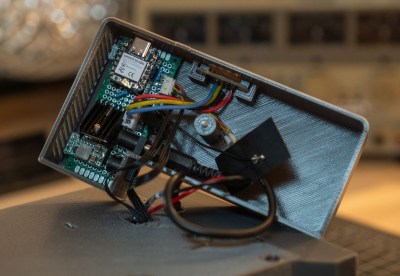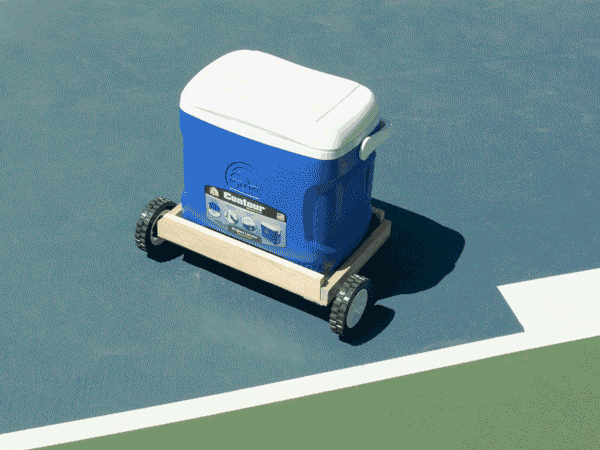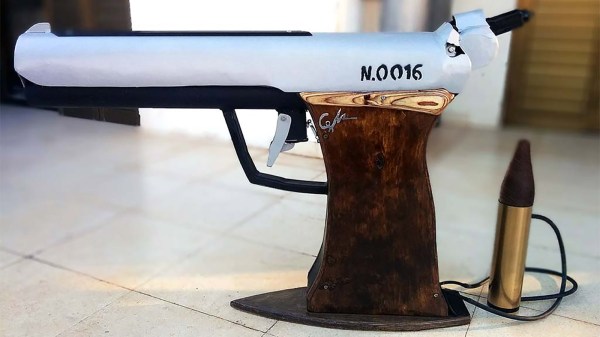[Bogdan Micea] uses a laptop cooler, but was a bit annoyed that his cooler would run at the same power no matter how hard the laptop was working. Rather than keep adjusting the cooler’s power manually, he automated it by installing an Arduino Pro Micro as a controller in the cooler and writing a Rust controller application for his computer.
[Bogdan]’s cooler is controlled by four buttons, which can have different functions depending on how long they’re pressed. After mapping out their functionality and minor quirks, [Bogdan] soldered four transistors in parallel with the buttons to let the Arduino simulate button presses; another four Arduino pins accept input from the buttons to monitor their state. The Arduino USB port connects to the cooler’s original USB power input, so the cooler looks superficially unchanged. When the cooler starts up, the Arduino sets it to a known state, then monitors the buttons. Since it can both monitor and control the buttons, it can notify the computer when the cooler’s state changes, or change the state when the computer sends a command.
On the computer’s part, the control software creates a system tray that displays and allows the user to change the cooler’s current activity. The control program can detect the CPU’s temperature and adjust the cooler’s power automatically, and the Arduino can detect the laptop’s suspend state and control power accordingly.
Somewhat surprisingly, this seems to be the first laptop cooler we’ve seen modified. We have seen a laptop cooler used to overclock a Teensy, though, and a laptop’s stock fans modified.
cooler22 Articles
Thermoelectric Module Keeps Printer Filament Cool And Dry
Anyone who has left their car windows open during a rainstorm will tell you the best way to dry the upholstery is to crank the AC and close the windows. A couple of hours later, presto — dry seats. The same can be said for 3D printer filament, and it’s pretty much what [Ben Krejci] is doing with this solid-state filament dryer.
The running gear for this build is nothing fancy; it’s just a standard thermoelectric cooling module and a fan. The trick was getting the airflow over the module right. [Ben] uses two air inlets on his printed enclosure to pull air from the cold side of the Peltier, which allows the air enough time in contact with the cold to condense out the water. It also allows sufficient airflow to keep the hot side of the module from overheating.
 Water collection was a challenge, too. Water always finds a way to leak, and [Ben] came up with a clever case design incorporating a funnel to direct water away. The module is also periodically run in reverse to defrost the cold side heatsink.
Water collection was a challenge, too. Water always finds a way to leak, and [Ben] came up with a clever case design incorporating a funnel to direct water away. The module is also periodically run in reverse to defrost the cold side heatsink.
The dehumidifier lives in a large tool cabinet with plenty of room for filament rolls and is run by an ESP32-C3 with temperature and humidity sensors, which allowed [Ben] to farm most of the control and monitoring out to ESPHome. The setup seems to work well, keeping the relative humidity inside the cabinet in the low 20s — good enough for PETG and TPU.
It’s an impressively complete build using off-the-shelf parts. For a different approach to solid-state filament drying, check out [Stefan]’s take on the problem.
Centaur Costume Features Drinks Cooler And Walking Legs
Let’s say it’s Halloween, and you’re a big fan of centaurs. At the same time, you want to be easily able to store your drinks on ice and always have them to hand. Well, this costume from [David Yakos] might be the one for you.
Construction is simple. Two small bike wheels were fitted to the cooler using bits of a broken chair, and the other end of the cooler is simply fitted around the wearer’s waist with a strap.
The rear centaur legs are carved out of foam board, and attached to the rear wheels with a bolt through the spokes. The top of each leg is attached to a rod, which slides into the frame holding the wheels on. It keeps the top of the legs roughly where they should be but lets them move, allowing the legs to “walk” as the wheels rotate.
It’s not exactly an advanced build, but we simply love the idea of costumes that keep drinks cold all night. Hiding the cooler as a centaur’s body is really just the icing on the cake. Of course, if you’ve got your own costume design for keeping your beverages chilled and frosty, do let us know. Video after the break.
Continue reading “Centaur Costume Features Drinks Cooler And Walking Legs”
Automate The Freight: Amazon Tackles The Last Mile Problem On Wheels
We’ve been occasionally exploring examples of what could be the killer application for self-driving vehicles: autonomous freight deliveries, both long-haul and local, as well as some special use cases. Some, like UAV delivery of blood and medical supplies in Kenya, have taken off and are becoming both profitable and potentially life-saving. Others, like driverless long-haul trucking, made an initial splash but appear to have gone quiet since then. This is to be expected, as the marketplace picks winners and losers in a neverending quest to maximize return on investment. But the whole field seems to have gotten a bit sleepy lately, with no big news of note for quite a while.
That changed last week with Amazon’s announcement of Scout, their autonomous delivery vehicle. Announced first on Amazon’s blog and later picked up by the popular and tech press who repeated the Amazon material almost verbatim, Scout appears at first glance to be a serious attempt by Amazon to own the “last mile” of delivery – the local routes that are currently plied by the likes of UPS, FedEx, and various postal services. Or is it?
Continue reading “Automate The Freight: Amazon Tackles The Last Mile Problem On Wheels”
Artistic Images Made With Water Lens
It’s said that beauty and art can be found anywhere, as long as you look for it. The latest art project from [dmitry] both looks in unassuming places for that beauty, and projects what it sees for everyone to view. Like most of his projects, it’s able to produce its artwork in a very unconventional way. This particular project uses water as a lens, and by heating and cooling the water it produces a changing image.
The art installation uses a Peltier cooler to periodically freeze the water that’s being used as a lens. When light is projected through the frozen water onto a screen, the heat from the light melts the water and changes the projected image. The machine uses an Arduino and a Raspberry Pi in order to control the Peliter cooler and move the lens on top of the cooler to be frozen. Once frozen, it’s moved again into the path of the light in order to show an image through the lens.
[dmitry] intended the project to be a take on the cyclical nature of a substance from one state to another, and this is a very creative and interesting way of going about it. Of course, [dmitry]’s work always exhibits the same high build quality and interesting perspective, like his recent project which created music from the core samples of the deepest hole ever drilled.
A Beverage Cooler That Comes To You!
Feel like taking a long walk, but can’t be bothered with carrying your drinks? Have no fear, this “Follow Me” Cooler Bot is here!
Really just a mobile platform with a cooler on top, the robot connects to smartphone via Bluetooth, following it using GPS. Making the platform involves a little woodworking skill, and an aluminium hub with a 3D-printed hub adapter connects the motors to a pair 6″ rubber wheels with a swivel caster mounted at the rear. A pocket in the platform’s base houses the electronics.
The Arduino Uno — via an L298n motor driver — controls two 12V DC, brushed and geared motors mounted with 3D printed brackets, while a Parallax PAM-7Q GPS Module in conjunction with an HMC 5883L compass help the robot keep its bearing. A duo of batteries power the motors and the electronics separately to prevent any malfunctions.
Beer Gun Shoots Non-Lethal Doses Of Beverages
[Michalis Mavros] likes building things from steel. Guns are from steel. He and his friends also like action movies and beer. To address everybody’s needs [MakeItExtreme] style, he built a gigantic beer gun. At the size and caliber of a small field artillery cannon, the spectacular piece of art dispenses chilled pop cans for unsuspecting movie night visitors.
Continue reading “Beer Gun Shoots Non-Lethal Doses Of Beverages”


















